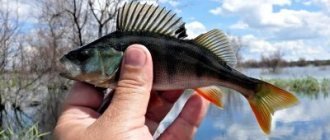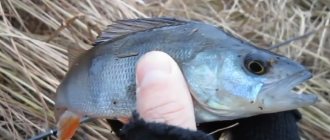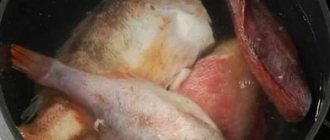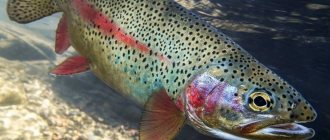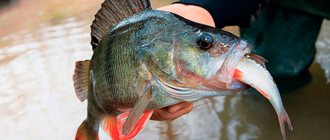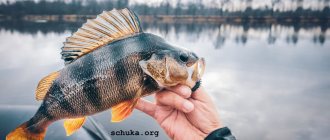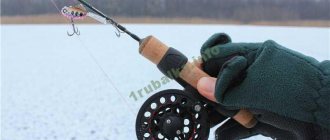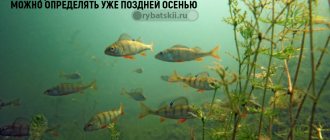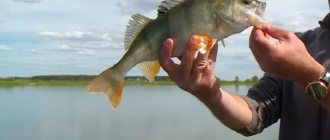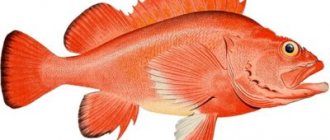Growing common perch fish
Details Category: Fish
Perches from the Regsa genus are considered a trash fish in Russia, but in developed countries (USA, Canada, Australia) they are bred (Fig. 81). There are proposals from US businessmen to breed common perch (see Fig. 81, a) in the CIS for sale in the USA, where fillets from it are valued several times higher than carp. In the USA, yellow or American perch is bred - Regsa flavescens, in our country there is a similar species - P.fluviatilis, and in Lake Balkhash there is an endemic - Balkhash perch P.schrencki, listed in the International Red Book.
According to many ichthyologists, the American perch is a subspecies of the common perch. Their main distinguishing feature is the number of scales in the lateral line: the American has 74-88, and the common one has 58-68. In terms of nutritional value and growth rate, ordinary, or river, perch is not inferior to American perch. At the same time, river perch grows large - 45 cm (American - 30 cm); ripens in the 3rd-4th year, but in mass - later, in the 4th-6th year. Perches are predators, but at an early age they are planktivores and feed all year round. Upon reaching 2-5 cm, bottom organisms are also consumed, especially nektobenthic ones - mysids, gammarids, juvenile crayfish, etc. Adults, in the absence of small fish, continue to readily feed on crustaceans. They grow differently in the first years of life, depending on the availability of food (Table 147).
Table 147. Growth rate of common perch
| Growth rate | Age, years | ||||
| 1+ | 2+ | 3+ | 4+ | 5+ | |
| Length, cm | 6-9 | 9-14 | 11-18 | 18-22 | 20-28 |
| Weight, g | 3-10 | 30-50 | 80-120 | 140-180 | 160-200 |
In countries where it is considered a dietary fish, perch reaches marketable weight (100-120 g) in the 3rd year. Perch spawns earlier or simultaneously with pike when the water warms up to 5-10°C in March-April, the peak of spawning is at 10-20°C in May. Embryonic development lasts 13-14 days, the size of hatched larvae is 1.8-2 mm. The yolk sac completely dissolves on the 10th day at a temperature of 15°C. The fertility of perch is from 12 to 300 thousand, on average (working) - 30 thousand eggs. Obtaining perch offspring is not difficult. Breeders with a length of more than 20 cm caught in the fall are placed at a planting density of 100-300 pcs. on 0.1 hectares in a wintering pond, where they overwinter well along with carp. If aeration is provided in winter huts, planting density can be increased. For better ripening through the ice holes where the aerator is installed, perch producers must be fed with earthworms. If they have not been prepared in advance or are not cultivated on the farm, then in the fall 1-2 thousand small trash fish (buck, gudgeon, etc.) are released into the pond. In spring, harvesting spawners on rivers and lakes is difficult, since they can begin spawning when the shore is still covered with ice. Spawning takes place in a regular carp spawning tank. For this you need a substrate - reed roots, spruce branches of coniferous trees, willow branches, etc. The caviar is bottom, sticky. 3-6 females and 3-4 males are planted in a spawning area of 0.01 hectares. The yield from caviar is 80%. The larvae switch to mixed feeding after 7 days, and to active feeding after 14-15 days. Caught larvae can be reared using intensive technology in pools or trays at a temperature of 20-30°C, using a trout farming scheme. The food, in addition to minced fish, worms and crustaceans, can be granulated, used for trout, sturgeon or channel catfish. With this technology and the specified temperature, marketable perch can be obtained in 2 years or earlier, instead of 3 years. The extensive method is simpler and does not require costs: juveniles are grown in a polyculture with two-year-old carp. Breeders and replacements of perch are kept in breeding and replacement ponds along with carp and silver carp. The planting density of perch with two-year-old carp without bighead carp is 10-20 thousand pieces/ha, with bighead carp, a competitor in feeding on zooplankton, is 3-5 thousand pieces/ha. Fingerlings weighing 6 g overwinter in carp wintering ponds, where feeding is carried out, or, if they are raised in a monoculture, in the same ponds. To grow perch in monoculture, you can use an overgrown lake or ravine pond, where fish productivity for carp will be low. In the 2nd year, the average weight of perch will be about 40 g. It, like fingerlings, can be raised with two-year-old carp and silver carp. To feed perch, it is necessary to have 2-3 carp nests per 1 hectare in the pond, the larvae of which will serve as food for the perch. Other predators - catfish, bester and pike - cannot be grown in a polyculture with perch. The planting density of perch in the 2nd year, depending on feed, is 1-5 thousand pieces/ha; Wintering in the second year is the same as for fingerlings. But with higher densities, feeding is required once a week. Three-year-old fish are grown at a stocking density of 1-3 thousand pcs/ha with peaceful fish of the same weight - 40 g. The perch reaches a marketable weight of at least 100 g in August, then you can begin selling it, catching it selectively using a seine. With this technology, the planting density of perch can be increased to 5 thousand pieces/ha. After catching, other individuals begin to grow more actively, and the marketable mass reaches 100%. The food is trash fish or fry of carp and silver crucian carp, the spawners of which are specially released into the feeding pond. In the absence of food for carp, polyculture is recommended in the southern regions: silver carp + grass carp + pike perch + perch.
Fish Farmer's Handbook. IN AND. Kozlov
Fishing for perch in the pond
Fishing for perch in large waters is becoming more and more popular today. Methods and strategies for pond fishing are somewhat different from those used outside the pond.
Pond perches are limited in space and are not accustomed to daily contact with people. Any sudden violation of order puts them on guard and forces them to take cover. Vibrations, including the noise produced by fishermen walking along the shore, are reflected in the water, and the perch immediately feels it.
That's why you need to sneak up to the pond unnoticed. When fishing with other fishermen, you need to maintain silence and if you talk, do it very quietly and try not to make noise on the shore.
You also need to give the fishing spots a rest. You need to take a break and not fish in one place more than once a week. Pond perch is very sensitive, and if you spook it, you need to wait several days for it to return to its original place.
If fishing on a pond with a boat is preferred, it is recommended to use the quietest possible vehicle. You need to lubricate the locks on the oars and put a carpet on the floor to muffle any sounds of gear or anything else scraping the bottom.
Read: Catching perch with live bait
One of the advantages of pond fishing is that it is easier to find fish on a pond than on any other body of water. You need to catch each spot as much as possible before moving on to another. If the fish is not caught in the first selection of baits, you should use a variety of other baits until you are sure it is time to move. Mostly in ponds there are not very large specimens of this fish, mostly fish weighing from 170 to 250 grams. In this regard, baits are used specifically for such a small size. Lures can be: small twisters and vibrotails, wobblers up to 6 millimeters long, foam fish, silicone baits and a number of others.
Another important difference between ponds and other types of water bodies is the size of the baits that are used. Smaller lures that make less noise as they end up landing in or moving through the water are preferred.
Another important factor in fishing for pond perch is the weather. This type of fish prefers windy or rainy days. Wind helps disguise the presence of the fisherman, and rain makes the fish more aggressive. In addition, if the pond has a drainage or a ditch leading into it, you can count on the perch to be found in this place, because these things have such an influence on the aggressiveness of this fish.
Largemouth (Black) Bass (Part 3)
When growing larger fish, the density of juveniles in ponds should be reduced to 25-30 thousand fish/ha. The duration of rearing juveniles before harvesting and sale in this case is naturally longer than in the first case. If large-sized fingerlings are grown, fertilizers are used, but in these cases nutrients are added to stimulate the growth of not only zooplankton, but also phytoplankton. Phytoplankton are consumed by aquatic insects, which in turn feed on the young largemouth bass. The feeding habits of juvenile largemouth bass in pond systems were studied by Rogers (1967). It has been established that the most important components of perch food are copepods and cladocerans. The diet of perch fry less than 15 mm long is dominated by copepods and cladocerans, while larger individuals feed mainly on mosquito larvae. Cannibalism makes intensive largemouth bass farming difficult. Hutson (1976b) lists factors contributing to cannibalism as over-compaction of ponds, stocking of ponds with fry of different sizes, insufficient development of natural food organisms for fish, and delays in harvesting (leading to fry of different sizes appearing in ponds). Snow (1973, 1975) describes the operation of a somewhat more intensive culture system for largemouth bass. Ponds or canals are used as cultivation containers, and the fish are kept on artificial feed. Traditional largemouth bass culture systems do not use artificial feeds, but Oregon wet pellets (OWP) have proven to be quite suitable. In the early stages of the life cycle, food for juveniles continues to be zooplankton. But as soon as the fish grow up, they can be transferred to OVG. It is not difficult to train largemouth bass to take OVG. A high-intensity culture method for largemouth bass involves the use of nylon spawning beds (Chastain and Snow, 1965), which are removed from the spawning ponds after the eggs have been laid on them. The eggs are collected from spawning grounds and placed in special vessels, where they are incubated and hatched. The larvae are kept in special tanks and fed artificial food during the post-larval stage. Another option is also possible: the larvae colonize pre-fertilized ponds in which zooplankton develops, and later the fish are transferred to artificial food. Diseases, parasites and predator control. Snow (1975) suggests treating largemouth bass spawners against external parasites with a formaldehyde solution at a concentration of 25 mg/l, and when using artificial food, introducing medicinal substances into it. Largemouth bass are susceptible to a variety of diseases and parasites, which sometimes cause significant mortality, especially among fry and fingerlings. Davis (1967) cites in his work cases of detection of myxobacteria and parasites such as Ichthyophthirius, Costia, Trichodina, Trichophyra and Scyphidia in perch individuals. Treatment methods may be similar to those used to treat channel catfish and other fish species. Predatory insects can pose a great danger to largemouth bass fry and fingerlings. A particularly dangerous predator is the smooth fish (Notonecta) (Davis, 1967). Diesel fuel added to water forms a thin film on its surface, which almost instantly kills air-breathing insects, including smoothies and some other dangerous predators. This procedure is harmless for fish, and the film of diesel fuel dissipates in one to two days. Meehean (1937) recommended using kerosene at a rate of 100-120 l/ha to combat insects and predators; approximately the same concentration of diesel fuel should be sufficient.
- Largemouth (Black) Bass (Part 2)
- Largemouth (Black) Bass (Part 1)
- Silver crucian carp (part 2)
- Silver crucian carp (part 1)
- Pimephales blackhead
- American bream (Notemigonus)
- Small carp fish for bait (part 2)
- Small carp fish for bait (part 1)
- Historical sketch of bait farming (part 2)
- Historical sketch of bait farming (part 1)
- Processing and marketing (part 2)
- Processing and marketing (part 1)
- Specialized Breeding Methods
- Transportation of live fish (part 2)
- Transportation of live fish (part 1)
- Fishing in extensive cultivation systems (part 2)
- Fishing in extensive culture systems (part 1)
- Harvesting in intensive culture systems
- Diseases and enemies of oysters
- Shrimp diseases and parasites
- Other common fish diseases
- Channel catfish copepods
- Helminths of channel catfish
- Parasitic protozoa of channel catfish (part 2)
- Parasitic protozoa of channel catfish (part 1)
- Mycotic diseases of channel catfish
- Channel catfish viral disease (CDVD)
- Stress swim bladder syndrome
- Nutritional diseases of fish (part 2)
- Nutritional diseases of fish (part 1)
Perch and roach
Their proximity can only end well in one case, if the perch is fed to its fill. This voracious type of fish could completely kill the roach, if not for its fertility and adaptation to different living conditions. Experienced fishermen know that where the roach is biting, more than one “humpback fish” is on duty nearby, waiting for the opportunity to snatch the careless fish from the school.
Nature has wisely arranged everything; the predator fish coexists with the prey fish, eating its fry or small relatives, regulating the population. Over the course of many years, the prey develops increased fecundity, a color that helps it hide in river mud or algae. In relation to pike, we can give a clear answer; there are few types of fish that represent competition for it; of all those listed, this is pike perch. The rest serve as food for her; the predator chooses which one is preferable depending on the time of year and surrounding food resources.

